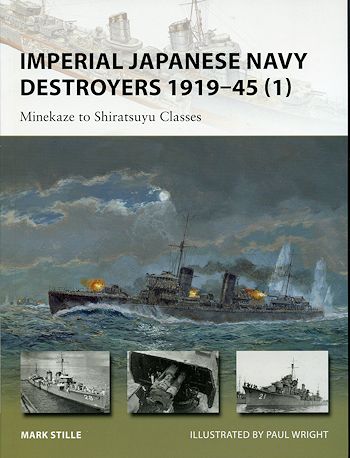 One
of the most prolific of what I'll call full size combatants in any navy is the
destroyer. These are, in most cases, multipurpose ships capable of gunfire
support, torpedo attacks and anti-submarine warfare. They are prolific as they
are relatively inexpensive to build compared to some of the large classes of
ships and can be built relatively expensively.
One
of the most prolific of what I'll call full size combatants in any navy is the
destroyer. These are, in most cases, multipurpose ships capable of gunfire
support, torpedo attacks and anti-submarine warfare. They are prolific as they
are relatively inexpensive to build compared to some of the large classes of
ships and can be built relatively expensively.
These were originally designed to be torpedo boat destroyers to protect
the fleet from the fast, but possibly deadly torpedo boats. The name destroyer
simply stuck.
The Japanese have historically been hampered by an inability to build
the sort of navy that many other major powers had available to them. As today,
finances were the major hurdle as well as not having the materials so when a
naval ship was built, it had to be quantitatively good. The Japanese also saw
the role of the destroyer in a somewhat different light from other navies. Their
primary purpose was as torpedo attack against larger enemy ships. The
bigger ships were to hammer the capital ships and the destroyers were to dash in
with their high speed, unlease a major spread of torpedoes, withdraw, reload
(something other nations' destroyers could not do), and get ready for the next
attack. This was practiced long and hard. As was attacking at night, making the
Japanese navy the best in the world at this sort of attack.
It was very much worth the effort as the Japanese used this form of
battle with great success in the early years of the war, much to the detriment
of Allied navies who were on the receiving end. However, this came at a cost as
the Japanese destroyer fleet was severely lacking in anti-submarine capability
and were not armed well for anti-air purposes. Probably no surprise that the
vast majority of Japanese destroyers were lost to submarines and air attack.
This book covers the various classes from Minikaze through Shiratsuyu
and include the Kamikaze, Mitsuk, Fubuki, Akatsuke, and Hatsuharu builds. Each
ship class is described and a brief history of each ship in the class is
provided, including its eventual fate. This is further enhanced by at least one
well done photo of each class as well as the art work of Paul Wright showing
some of these ships in action.
It all makes for an excellent primer on these ships and is a book that
every nautical enthusiast has to have on their shelves. Most highly recommended.
April 2013
For more on the complete line of Osprey books,
visit www.ospreypublishing.com. In the US, it is
Osprey Direct at 44-02 23rd St, Suite 219, Long Island City, NY 11101., where you can
get a catalogue of available books.
If you would like your product reviewed fairly and quickly, please
contact
me or see other details in the Note to
Contributors.
 One
of the most prolific of what I'll call full size combatants in any navy is the
destroyer. These are, in most cases, multipurpose ships capable of gunfire
support, torpedo attacks and anti-submarine warfare. They are prolific as they
are relatively inexpensive to build compared to some of the large classes of
ships and can be built relatively expensively.
One
of the most prolific of what I'll call full size combatants in any navy is the
destroyer. These are, in most cases, multipurpose ships capable of gunfire
support, torpedo attacks and anti-submarine warfare. They are prolific as they
are relatively inexpensive to build compared to some of the large classes of
ships and can be built relatively expensively.